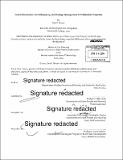| dc.contributor.advisor | Albert Saiz. | en_US |
| dc.contributor.author | Brown, Sara E | en_US |
| dc.contributor.other | Massachusetts Institute of Technology. Center for Real Estate. Program in Real Estate Development. | en_US |
| dc.coverage.spatial | n-us-pa n-us-ny n-us-ma | en_US |
| dc.date.accessioned | 2014-09-19T21:39:07Z | |
| dc.date.available | 2014-09-19T21:39:07Z | |
| dc.date.copyright | 2014 | en_US |
| dc.date.issued | 2014 | en_US |
| dc.identifier.uri | http://hdl.handle.net/1721.1/90090 | |
| dc.description | Thesis: M.C.P., Massachusetts Institute of Technology, Department of Urban Studies and Planning, 2014. | en_US |
| dc.description | Thesis: S.M. in Real Estate Development, Massachusetts Institute of Technology, Program in Real Estate Development in conjunction with the Center for Real Estate, 2014. | en_US |
| dc.description | Cataloged from PDF version of thesis. | en_US |
| dc.description | Includes bibliographical references (pages 129-137). | en_US |
| dc.description.abstract | This thesis considers two interrelated sources of blight in cities: so-called "problem properties" (PP), or properties in poor physical condition where owners have stopped performing basic maintenance, and tax-delinquent properties (TDP), where owners have stopped paying their property taxes. It focuses on how cities can be more effective in addressing PP and TDP both "before" (through proactive prevention) and "after" (through correction/collection) they emerge. Fundamentally, it argues that cities should recognize the relationship between PP and TDP, which often constitute the same properties, but, more importantly, both can be "liened up" and taken through foreclosure if their owners are truly unresponsive. These liens can be established through unpaid code violation fines and receivership liens, as well as unpaid taxes. This approach is based on the premise that cities want to receive as few properties as possible through foreclosure, because of the costs associated with holding excess land and buildings, but also want to avoid the "worst of the worst" PP and TDP becoming a blight on neighborhoods. Thus, if owners are going to refuse to correct severe code violations and/or delinquency, cities want to transfer properties to responsible owners as quickly as possible. Recognizing the links between PP and TDP enables cities to switch from a reactive to proactive approach in treating blight. This thesis also discusses barriers to addressing PP and TDP. It suggests that cities treat them through comprehensive "enforcement pathways" targeted to specific property and owner types. In particular, owners are divided into three groups: cooperative, non-cooperative, and "missing in action." This segmentation methodology recognizes that different properties present different enforcement challenges and require different strategies to return them to productive use. In addition, this thesis examines the three collection methods available to cities: public collection, contracted third-party servicing, and privatized collection (tax lien sales), and addresses a major limiting factor on tax lien sales: their dependence on private market demand. Finally, it examines how cities can be more effective in managing and disposing of their property inventories. To guide property usage and disposition timing, it suggests that cities establish a central property inventory that includes critical land and building characteristics, a property potential reuse scoring system, and a market model that segments neighborhoods and identifies spatial and temporal "inflection points." It also recommends that cities not take a "one size fits all" approach to their entire inventory, but rather select the disposition method, -- sheriff's sale/auction, RFP, third-party transfer, or land banking, -- that is most appropriate for the property type, (sub)market condition, and desired outcome(s). Finally, it outlines strategies to overcome under-management of public assets, weak markets, and financing challenges. To support the discussion about how to best manage delinquency and disposition, it includes detailed case studies of Philadelphia, New York City, and Boston. | en_US |
| dc.description.statementofresponsibility | by Sara E. Brown. | en_US |
| dc.format.extent | 137 pages | en_US |
| dc.language.iso | eng | en_US |
| dc.publisher | Massachusetts Institute of Technology | en_US |
| dc.rights | M.I.T. theses are protected by copyright. They may be viewed from this source for any purpose, but reproduction or distribution in any format is prohibited without written permission. See provided URL for inquiries about permission. | en_US |
| dc.rights.uri | http://dspace.mit.edu/handle/1721.1/7582 | en_US |
| dc.subject | Urban Studies and Planning. | en_US |
| dc.subject | Center for Real Estate. Program in Real Estate Development. | en_US |
| dc.title | Code enforcement, tax delinquency, and strategic management of problematic properties | en_US |
| dc.type | Thesis | en_US |
| dc.description.degree | M.C.P. | en_US |
| dc.description.degree | S.M. in Real Estate Development | en_US |
| dc.contributor.department | Massachusetts Institute of Technology. Center for Real Estate. Program in Real Estate Development. | en_US |
| dc.contributor.department | Massachusetts Institute of Technology. Center for Real Estate | |
| dc.contributor.department | Massachusetts Institute of Technology. Department of Urban Studies and Planning | |
| dc.identifier.oclc | 890142793 | en_US |

